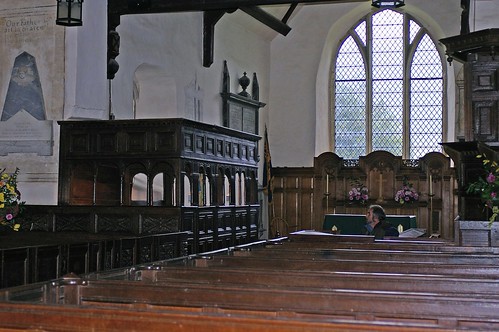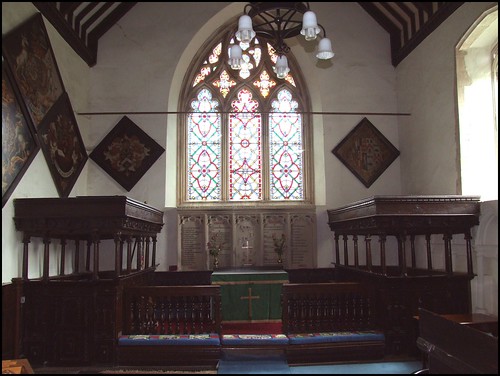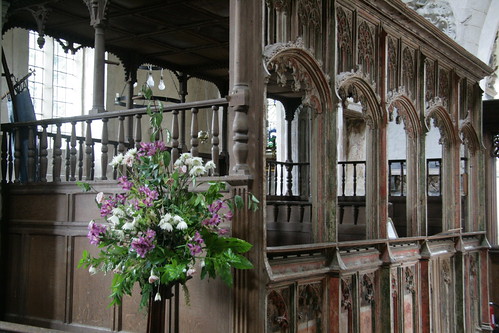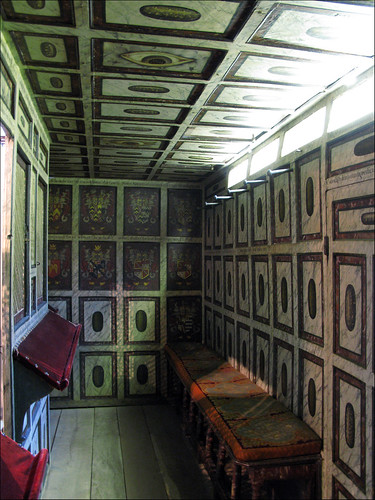The Family Pew
After the Dissolution--the biggest legal transfer of wealth in England's history--the Crown either bestowed or sold the church properties to peers and gentry. By far, most of the estates went to the landed gentry, and thus emerged to prominence, in essence for the first time there, the aristocracy.
The gentleman manifested his status in a number of ways, whether by extensivedesecration renovation of the appropriated abbeys and convents into great country houses (in one case, the gatehouse was brutally driven through the nave of an old parish church), or by riding about in ornate coaches, or by constructing the family pew (usually in the impropriated parish church of which he was patron). The family pew served not only to preserve a permanent place for the (invariably non-Catholic) squire's family at church, but also to distinguish them from the rest of the populace, and to denote their patronage of the parish. Many pews, therefore, were elaborately built, with delicate woodwork and heraldic crests, and made to stand out. The squire's pew was always placed at the head of the nave, in a personal side chapel, or even (for the humblest gentry) in the sanctuary, where the squire could sit as equals with the preacher. Pews were the very sign of hierarchy, the landed family entering and sitting prominently ahead of their neighbors, thus furnishing an excellent example of Our Lord's teaching in Luke 14:7-14.

Tichborne Family Pew, with armorial carving, at St. Andrew's in Alresford

Interior of Lulham Family Pew, Herefordshire, complete with looking glass into which the family of gentle birth could gaze when their minds wandered away from the sermon

No, it's not a confessional. Sir Thomas Gawdy's pew in Norfolk was described, by one disgusted cleric, as "of a monstrous height, curtained like a bedstead, and encroaching upon the alley." One wonders if others may have entertained similar thoughts with regard to the above unknown manorial family pew.

Stokesay Family Pew in Shropshire

Cotton Family Pew in Alstonefield

Wingfield Family Pews in All Saints, Suffolk; apparently, the attention-loving family deemed themselves so important their pews flank either side of the altar in the chancel; above are heraldic crests

Barnardiston Family Pew, Sts. Peter and Paul, Kedington, assembled in 1610 from pieces of the medieval screen that once separated the Holy of Holies from the rest of the church, but dissembled for the more fitting purpose of constructing a private sitting place for Important Persons

Inconspicuous exterior of Kederminster Family Pew, 1630s, painted to resemble marble

Interior of Kederminster Family Pew, decorated with coats of arms, and containing hat pegs and benches.

Ferneley Family Pew, 1828, featuring Mrs. Ferneley and her six children (and the ghostly outline of an unfinished Mr. Ferneley) at St Mary's Parish Church in Melton Mowbray, endeavouring not to fall asleep during the vicar's sermon
The gentleman manifested his status in a number of ways, whether by extensive

Tichborne Family Pew, with armorial carving, at St. Andrew's in Alresford

Interior of Lulham Family Pew, Herefordshire, complete with looking glass into which the family of gentle birth could gaze when their minds wandered away from the sermon

No, it's not a confessional. Sir Thomas Gawdy's pew in Norfolk was described, by one disgusted cleric, as "of a monstrous height, curtained like a bedstead, and encroaching upon the alley." One wonders if others may have entertained similar thoughts with regard to the above unknown manorial family pew.

Stokesay Family Pew in Shropshire

Cotton Family Pew in Alstonefield

Wingfield Family Pews in All Saints, Suffolk; apparently, the attention-loving family deemed themselves so important their pews flank either side of the altar in the chancel; above are heraldic crests

Barnardiston Family Pew, Sts. Peter and Paul, Kedington, assembled in 1610 from pieces of the medieval screen that once separated the Holy of Holies from the rest of the church, but dissembled for the more fitting purpose of constructing a private sitting place for Important Persons

Inconspicuous exterior of Kederminster Family Pew, 1630s, painted to resemble marble

Interior of Kederminster Family Pew, decorated with coats of arms, and containing hat pegs and benches.

Ferneley Family Pew, 1828, featuring Mrs. Ferneley and her six children (and the ghostly outline of an unfinished Mr. Ferneley) at St Mary's Parish Church in Melton Mowbray, endeavouring not to fall asleep during the vicar's sermon

<< Home